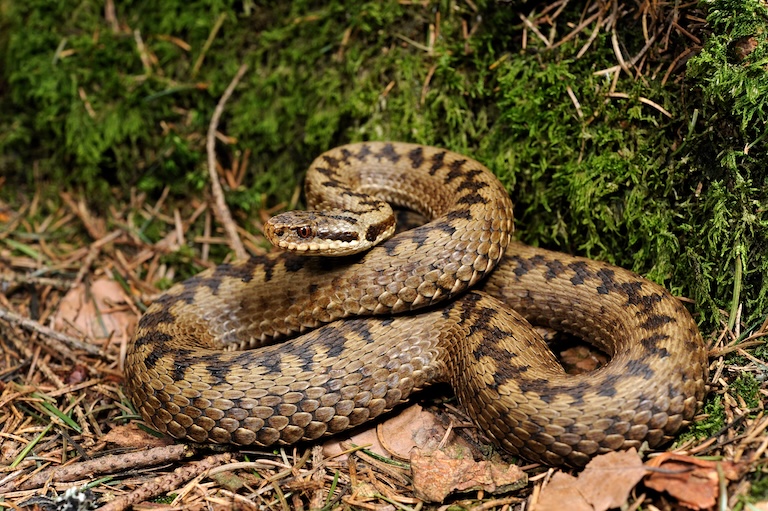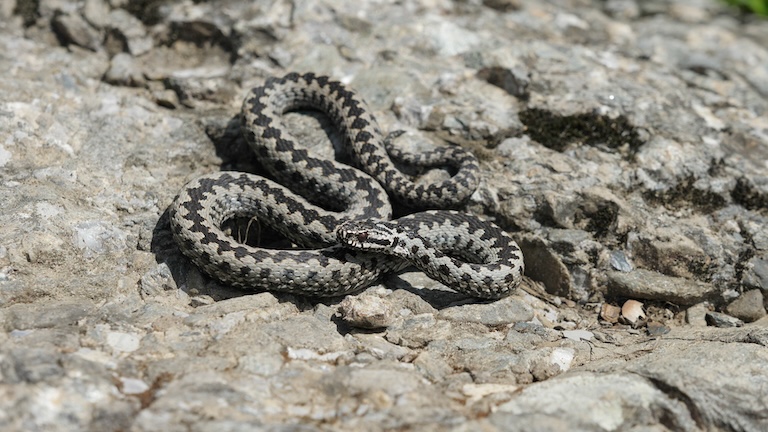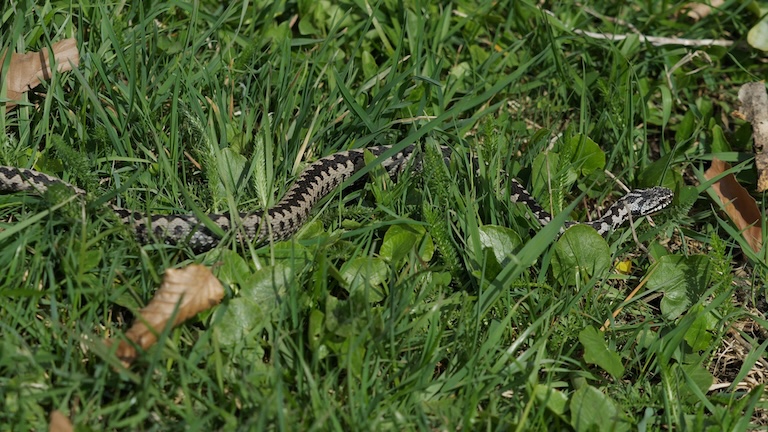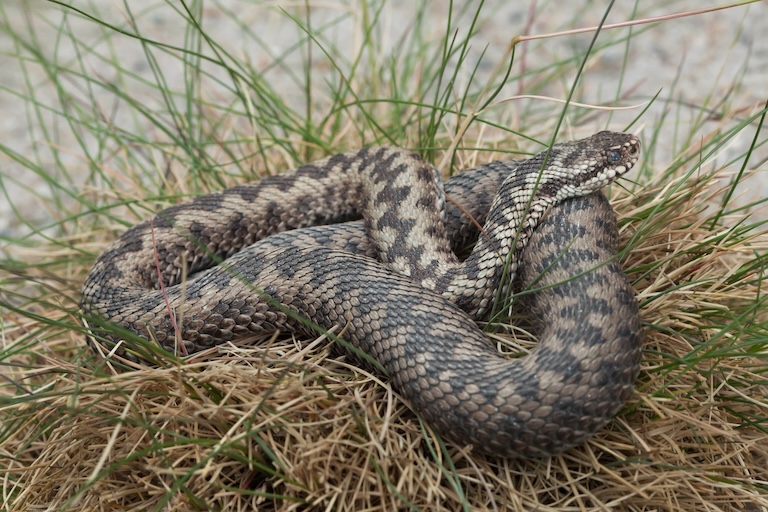Common Adder Profile
Arguably the UK’s most beautiful snake is also its most venomous. This is a cold-adapted cousin of the rattlesnake with a range that spans well beyond the ‘Isles and all the way into the West Pacific coast.
This is a snake whose presence in Europe earned it a cameo in the Old Testament, and whose frenzied dancing led to Druid myths about adder stones.
But the common adder is not a dangerous one, and while not threatened at the species level, does need our help locally.

Common Adder Facts Overview
| Habitat: | Woodlands, moorlands, heathlands, and wetlands |
| Location: | Widespread across temperate and cold Europe, Central Asia |
| Lifespan: | 15 to 25 in the wild |
| Size: | Up to 80 cm long (31 in) |
| Weight: | 180 g (6.3 oz) |
| Colour: | Variable, from blacks to browns, even green-yellow, with a contrasting black zig-zag pattern down the back |
| Diet: | Small mammals, reptiles, amphibians, some birds |
| Predators: | Foxes, badgers, raptors, other snakes |
| Top Speed: | Not very fast, relying more on camouflage and stealth |
| No. of Species: | 1 |
| Conservation Status: | Least Concern (IUCN) |
The Common, or Northern adder is a small viper species with a big range. This is one of the most widespread snakes in the world, thriving in a variety of habitats due to its adaptable diet and tolerance to the cold.
They live as far North as the Arctic Circle, and this range often puts them in contact with humans and their pets, a portion of whom inevitably get bitten.
But these bites are almost always harmless, outside of a handful of allergic reactions, and it’s much more important to consider this animal a key species than a dangerous one.
Interesting Common Adder Facts
1. They’re vipers
Believe it or not, the taxonomy of European vipers is far from settled, but molecular technology is certainly bringing the discipline closer.
There’s a stunning black viper called the forest-steppe viper that comes from Ukraine and Russia, which often hybridises with the Common adder and may in fact be a melanistic subspecies of it.
Likewise, the more sandy-looking Vipera sachalinensis from Asia and the Turkish V. barani are now both considered subspecies of the common viper, along with a few others once thought to be separate species.
These revelations came in the early 2000s and brought with them the new understanding that this viper occupies a dizzying range of habitats. 1

2. They’re adaptable
Adders are found in woodlands, moorlands, heathlands, and wetlands; wherever there is access to sun and food.
They like a bit of ground cover so that they’re not easily spotted, but they are otherwise quite unfussy animals and are very good with the cold.
They have behavioural plasticity when it comes to hibernation, spending about five or six months out of action in the British Winter and up to nine in the North of Sweden, but they’re also capable of travelling across snow. 2
3. They’re common
This range of abilities means that this is the most northerly-found snake and has one of the largest natural rangers of any venomous snake, too.
Their Arctic populations are contrasted by their conspecifics in the Mediterranean, and they span from the West coast of Portugal to the Eastern waters of Asia.
And they’re not just rangy but abundant, too. Water appears to be the strongest limiting factor, and this makes them exceptionally common.
And common animals often come into contact with the ever-growing human population.
4. They bite a lot
Human expansion has left very little space for wild animals in Europe, especially in crowded countries like Britain, where only around 13% of the land is wooded.
Here, domestic animals and livestock get bitten mostly, but even in Sweden, where almost 70% is covered in trees, there are around 1,300 bites per year on people.
Around 12% of these require hospitalisation, but this might not be as bad as it sounds.
5. They’re less dangerous than a peanut
With around 156 people per year going to hospital for snake bites in Sweden, it may appear that the adder is as dangerous as vipers are typically known to be, but the statistics aren’t telling the full story.
For one thing, Sweden has rapid and free, high-quality healthcare, so people are quite quick to make use of it, and for another, 88% of people bitten by these snakes don’t even bother.
But to compare it to another common threat: peanut allergy affects around 2% of people in Western countries, and Approximately 7%–14% of patients with it experience accidental peanut exposure annually. One‐third to one‐half of those exposed may experience anaphylaxis.
From the Swedish population of 10.6 million, these figures imply that there would be over 200,000 people with peanut allergy in the country, and at least 15,000 of them experience accidental exposure, with at least 5,000 of those experiencing anaphylaxis from it, making the humble peanut around 32 times as dangerous as the adder.
In the vast majority of cases, local pain and possibly swelling are the best you’re going to get, and that’s good because even if you can’t see them, adders are everywhere. 3 4

6. They’re possibly closer than you think
The adder as a whole is not a threatened species, but local populations often are. Human development has significantly fragmented their habitats, meaning they can’t move very far from where they’re born.
A good example of this is the adder population in London, cut off from other wild areas, London parks are refuges for wildlife, but also often prisons for them too.
Still, being able to step out of the suburban sprawl and find adders in a local public park down the street goes to show just how common they can be.
7. They can dance
So, the common adder is as common as the name suggests, yet most people have never even spotted one.
Their camouflage and stealth keep them away from casual passers-by, and this is why one of their most interesting behaviours is also a tremendously rare sight.
When mating season comes around, males and females will engage in a courtship dance, involving side-by-side undulations that, combined with the zig-zags on their backs, probably led to the myth about snakes hypnotising people.
Males will also dance with one another, but using a modified approach that involves them rearing up and pressing down on one another to assert dominance and win mating rights. These battles don’t involve any real biting, and are just harmless – though potentially exhausting – contests.
8. They’re the origin of snake oil
Hypnotism wasn’t the only unrealistic expectation forced upon this species. Adders were once thought to cure deafness by people living before medical degrees were a thing.
To do so, they’d be killed and their oils extracted, which were used to treat earache and deafness in people. As people caught onto this fraudulent practice, snake oil salesmen became synonymous with charlatanism; something which sadly continues in the form of homoeopathy and various “alternative” remedies.
Other strange and fallacious attributes were an inability to die before sunset, and curing its bite using by jumping over water. Druids thought they were the source of those cool rocks you find on the beach with holes eroded through them, and called the rocks adder stones.

Common Adder Fact-File Summary
Scientific Classification
| Kingdom: | Animalia |
| Phylum: | Chordata |
| Class: | Reptilia |
| Order: | Squamata |
| Family: | Viperidae |
| Genus: | Vipera |
| Species: | berus |
Fact Sources & References
- “Adder”, IUCN Red List.
- Kat Muir, “Vipera berus Adder, Northern Viper”, Animal Diversity Web.
- Jay A Lieberman (2021), “The global burden of illness of peanut allergy: A comprehensive literature review”, PubMed Central.
- David A Warrell (2005), “Treatment of bites by adders and exotic venomous snakes”, PubMed Central.
